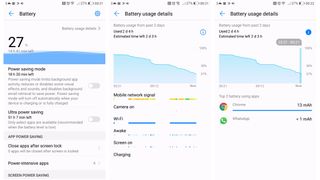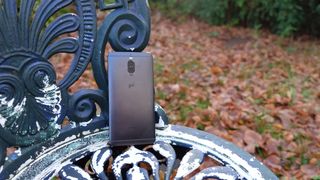Why you can trust TechRadar
Battery life
- Big 4,000mAh battery
- Impressive stamina
- Super charging really is very quick
Another shared component the Huawei Mate 9 Porsche Design has with the plain Huawei Mate 9 is its battery, which comes in at a very healthy 4,000mAh.
This is good news, because we were very impressed with the Mate 9’s stamina, and we’re similarly impressed here. Even with intensive usage, you’ll be able to get through a full day with the phone without needing a top-up.
Here’s a real use case scenario to give an idea of how the phone performs in real life. One morning we took the phone off charge at 9:30, and embarked on a day of moderate usage.
That included a constant - but by no means heavy - stream of email and message notifications, a couple of calls, some web browsing and direction finding on Google Maps, and around 15 minutes of 3D gaming. When we checked the battery at around 23:50, it was at 53%.
Interestingly, in our regular battery test, the Mate 9 Porsche Design out-performed its plain brother. The test involves a 90 minute looped 720p video, with the brightness turned right up and all notifications on.

This test consistently consumed 12% of the Porsche Design’s battery, which comfortably beats the Mate 9 on 17%. We’re not sure what the reason for this was - perhaps it was an update to the Video app or Emotion UI, or perhaps the smaller (though sharper) AMOLED display was simply more efficient at displaying this video, but it’s impressive any way you stack it.
It’s also worth pointing out that the Mate 9 Porsche Design pips the Samsung Galaxy S7 Edge, which lost 14% in the same test, and sports a similar 5.5-inch QHD AMOLED display.
Another impressive feat is the speed at which the Huawei Mate 9 Porsche Design recharges. It uses Huawei’s SuperCharge technology in conjunction with the USB-C standard to great effect.
Plugging it in with 43% charge on the clock - something you can reasonably expect to do after a long day of normal usage - it had climbed to 60% after ten minutes. In half an hour it was up to 80%, and after an hour of charging it reached 97%.
Huawei claims that you can reach a day’s worth of usage in just 20 minutes, and we can believe that to be true if you were charging from a lower starting point - this kind of quick-charging technology invariably slows as you reach full capacity.
Camera
- Dual-lens Leica-branded camera
- 20MP monochrome sensor, 12MP color one
- Wide aperture mode lets you change focus in post-production
Huawei clearly knew it was onto a pretty good thing with the dual-lens camera of the Huawei P9 and Huawei Mate 9, as it’s also used a dual-lens snapper for the Huawei Mate 9 Porsche Design.
It’s an innovative Leica-branded camera with one 12MP RGB sensor and one 20MP monochrome sensor. The primary intended function of this is to combine the images from both to produce sharper pictures than you could manage with a single sensor.
The idea is that the monochrome sensor is better able to capture fine detail. In practice we were impressed with the amount of detail packed into the pictures we took, but we wouldn’t say they were better than the likes of the single-sensor iPhone 7 or Samsung Galaxy S7.

Still, there are other benefits to this unusual dual-lens approach. The most notable is the ability to refocus shots after you’ve taken them - though you have to remember to select the ‘Wide aperture’ mode specifically in the camera UI.
In certain situations - chiefly in landscape shots with pronounced depth and layers - this can be quite a neat tool to have, as it almost guarantees you’ll be able to get the shot you want. It’s easy to control, too - just tap on the area of the picture you want to focus on, then save the results (the original will also be kept in the Gallery app). But its usefulness is otherwise quite limited.
The dual-lens setup also combines with optical image stabilization to make for some decent night time shots, though there was still plenty of noise in artificially lit indoor environments - which, let’s face it, is when most of us take our shots.

There’s also a Pro mode, which lets you micro-manage the usual range of settings such as ISO, shutter speed, and white balance.
Overall, the camera app itself is one of the better custom examples we’ve used, aping much of the style of the iOS equivalent but with a number of extra tricks.
The 8MP front camera doesn’t have any great tricks to boast of, but is perfectly fine at what it does - provided you give it plenty of light.
Camera samples









Current page: Battery life and camera
Prev Page What's it like to use? Next Page Verdict and competition
Scientists inch closer to holy grail of memory breakthrough — producing tech that combines NAND and RAM features could be much cheaper to produce and consume far less power

Google adds biometric verification to Play Store to keep your in-store wallet safe

Quordle today – hints and answers for Wednesday, April 17 (game #814)
